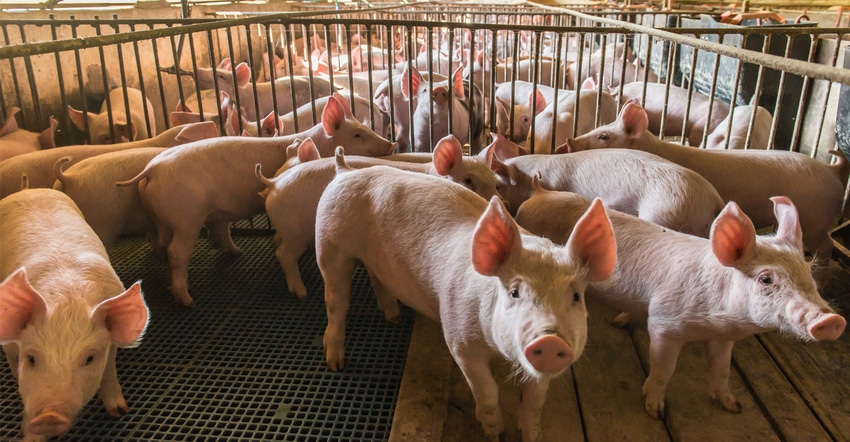
Things are looking up for South Dakota’s pork industry, according to the president of the South Dakota Pork Producers Council.
Shane Odegaard, a producer from Lake Preston, says he’s optimistic about pork production in the state. “The state of the pork industry in South Dakota is pretty exciting,” he says. “We’ve had pretty good growth over the last 10 years. Kind of numbers we’ve seen are in that 8% range growth year over year.”
According to the council, over 4 million pigs are born on South Dakota farms annually, with 2.8 million head marketed in 2019. The state ranks ninth in the nation for hog production and inventory.
Odegaard says an interesting part of that growth is in not only the number of finishing barns being built, but also who is building those finishing barns.
 PORK PRESIDENT: Shane Odegaard is the president of the South Dakota Pork Producers Council and shares updates for the industry.
PORK PRESIDENT: Shane Odegaard is the president of the South Dakota Pork Producers Council and shares updates for the industry.

Outside of current hog farmers, Odegaard says “quite a bit of growth” in contract finishing barns has been done by those not originally in the hog business. “You know there’s a young family, young generation coming back — sons and daughters looking for an opportunity to come back to the family farm. And so they’re building a contract finisher, to build equity in the operation” to support themselves and their families.
Odegaard says South Dakota is not a hog-dense state, but that can be a big selling point for producers looking to build sow farms — where the distance between neighboring hog facilities can improve overall biosecurity.
Good for grains
South Dakota’s hog industry does not exist within a silo, as the state’s grain production is integral to the industry’s viability. “Our basis level is wider in South Dakota than it is in our neighboring states, so that is also a driving force in both finishing and sow farms with the lower feed costs,” he says.
According to the council, South Dakota’s swine herd will yearly consume 35.5 million bushels of corn harvested from 221,750 acres, and 8.88 million bushels of soybeans coming from 193,232 acres.
Odegaard Family Farms is comprised of:
700 sows in a farrow-to-finish operation
4,000 head in a contract grower nursery
80 head in a cow-calf herd
1,800 acres of corn and soybeans
All the corn raised is kept for pig feed. Soybeans are marketed through a local cooperative, with some likely processed as soybean meal in Volga, S.D., and used as pig feed on the farm.
Others working at Odegaard Family Farms are Odegaard’s brothers Justin and Shaun, their uncle Randy, and Randy’s daughter Michelle and her husband, Heath, along with Ashley Pederson. Odegaard’s mother, Sharon, is a silent partner. Other family members, though not involved in the day-to-day operations, do pitch in when called upon.
Another positive outcome of a growing hog industry is what Odegaard calls the “trickle-down effect,” with allied industries such as feed mills, veterinarian supply companies, and equipment manufacturers and retailers providing an economic driver in the state. “It’s adding to the tax base and sales tax revenue for the state,” he says. “It’s good for the industry, and it’s good for the entire state.”
The council says the swine industry adds over $892 million to the state’s economy, and 7,900 jobs are created by the pork industry in the state.
Even though hog producers are sharing the same view of increased input costs as the rest of agriculture, Odegaard says 2022 “looks to be a profitable year for producers in South Dakota.”
Not all that oinks is gold
As with any year, there are obstacles facing South Dakota pork producers, and Odegaard says zoning and permitting of hog barns in some counties continues to be a battle.
“Some people just don’t want to have a hog barn built anywhere in their vicinity,” he says. “But the thing is, you have got to remember that we live in a rural agricultural community, and the ground is zoned for ag production. And just because there are people building acreages out there should not take away our rights to earn an income or farm in an ag-zoned area.”
Labor, or lack of, continues to be an issue across the country, and the pork production is not immune. “It doesn’t matter where you’re at, it doesn’t matter if you own a fast food restaurant or if you’re a farmer, everybody’s having those struggles with their labor right now,” he says.
Labor shortages have also impacted the harvest facilities, but Odegaard says most of the processing plants are operating at full capacity. However, a slowdown has occurred in processing pork product for consumers and retailers.
About the Author(s)
You May Also Like






